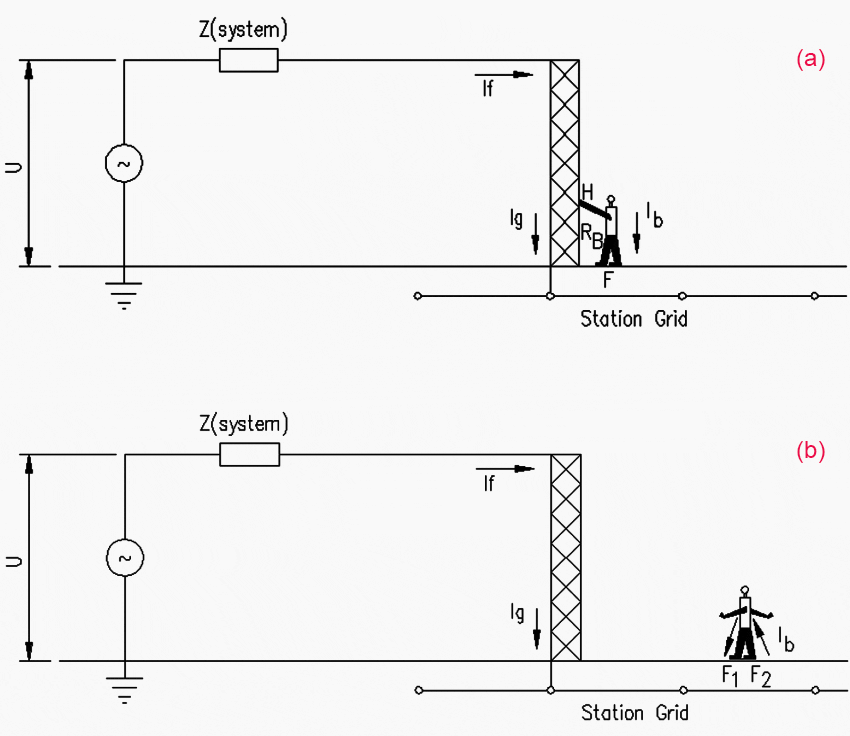The ground grid
The substation grounding system is an essential part of the every electrical system. The proper grounding of a substation is essential and very important for the following two reasons. First, it provides a means of dissipating electric current into the earth without exceeding the operating limits of the equipment.

Second, it provides a safe environment to protect personnel in the vicinity of grounded facilities from the dangers of electric shock under fault conditions.
The grounding system includes all of the interconnected grounding facilities in the substation area, including the ground grid, overhead ground wires, neutral conductors, underground cables, foundations, deep well, etc.
The following information is mainly concerned with personnel safety. The information regarding the grounding system resistance, grid current, and ground potential rise can also be used to determine if the operating limits of the equipment will be exceeded.
Safe grounding requires the interaction of two grounding systems:
- The intentional ground: consisting of grounding systems buried at some depth below the earth’s surface
- The accidental ground: temporarily established by a person exposed to a potential gradient in the vicinity of a grounded facility
It is often assumed that any grounded object can be safely touched. A low substation ground resistance is not, in itself, a guarantee of safety. There is no simple relation between the resistance of the grounding system as a whole and the maximum shock current to which a person might be exposed.

A substation with relatively low ground resistance might be dangerous, while another substation with very high ground resistance might be safe or could be made safe by careful design.
There are many parameters that have an effect on the voltages in and around the substation area. Since voltages are site-dependent, it is impossible to design one grounding system that is acceptable for all locations.
If the geometry, location of ground electrodes, local soil characteristics, and other factors contribute to an excessive potential gradient at the earth surface, the grounding system may be inadequate from a safety aspect despite its capacity to carry the fault current in magnitudes and durations permitted by protective relays.
During typical ground fault conditions, unless proper precautions are taken in design, the maximum potential gradients along the earth surface may be of sufficient magnitude to endanger a person in the area.
Moreover, hazardous voltages may develop between grounded structures or equipment frames and the nearby earth.
| Title: | Best practice in power substation grounding – Richard P. Keil; Commonwealth Associates, Inc. |
| Format: | |
| Size: | 1.00 KB |
| Pages: | 17 |
| Download: | Here 🔗 (Get Premium Membership) | Video Courses | Download Updates |



Sir
good day to you, I would like to ask the proper way of connecting earthing ground from sub transformer going to factory distribution board up to factory equipment panel, sir please send me drawing, highly appreciate if you see my mail, I work as maintenance engineer, I’m mechanical engineer not much knowledge about high voltage, this to have safety for the factory and my people working with me. our plant is around 300 meters away from sub station 400V
Thank you in advance
We’re getting the best concepts of electrical engineering on development of technology for ELV,LV,MV,HV,EHV and UHV power systems. I’m sending my special congratulation to the entire team who is organizing EEP informations.
From Professional Electrical Engineer Halid Mwasumile of United Republic of Tanzania.
Thank you very much Halid, that’s very kind of you.
I’m working in Jordan .I’m indian
Very educating and updating
Dear sirs
What are the membership fees?
Hi Khaled, all information about Premium membership you can find here:
https://electrical-engineering-portal.com/premium-membership